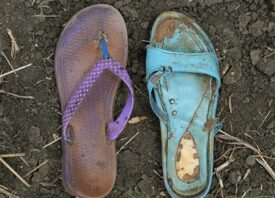Search this site
A Photographer’s Quest to Change the Way We Talk About Obesity

Kiss It! by Abbie Trayler-Smith is published by GOST Books.

Shannon was fourteen years old when she met the photographer Abbie Trayler-Smith. The artist was by Shannon’s side as she got ready for her prom, and later, when she got her first job. On vacation in Costa Del Sol in Spain, the pair of them laughed “til their bellies hurt.” Now, their years-long collaboration has culminated in the book Kiss It!, which weaves together a vibrant tapestry of one young woman’s experiences attending school, forging friendships, falling in love, pursuing her dreams, and living with obesity.
In truth, it’s two young women—not just one—who shine through these pages. Throughout, along with portraits of Shannon, Trayler-Smith has included diary entries from her own adolescence. As a teen in the 1990s, she wrote about feeling depressed and hoping to lose “two stone by Christmas.” She kept “diet diaries” to log her food intake. In junior high, the boy she liked wrote, “I hope you lose weight, love Mark” in her yearbook.
Now forty-five, Trayler-Smith returned to those since-forgotten diaries, finding herself at long last liberated from the self-abuse, disordered eating, and shame she’d endured in her girlhood. She credits Shannon with helping her along that path. Through Shannon, the artist was granted the rare opportunity to see and understand those early years differently than she had when she was in the thick of it.
“We shared so much over the years,” the photographer reflects. “Talking and listening to her revealed my own history. I began to see it reflected back to me in a new light. I realized the understanding and care I was giving to Shannon I had never given to myself.” We asked her to tell us more about the book, which has been twelve years in the making.

who bullied her. Sheffield, 2013 © Abbie Trayler-Smith
You first met Shannon after she read a poem at a press conference, as part of a community-based program for children and young people living with obesity. She was fourteen at the time. What do you remember from that first meeting?
Abbie Trayler-Smith: When Shannon read out her poem at the press conference I was covering, the room went silent. I got shivers because she was the brave teenager I had not been able to be. I explained what I wanted to do and asked if I could meet her Mum and come up for a cup of tea. I said I had been a fat teenager and wanted to make a piece of work about the psychological impact of growing up fat, an intimate portrait of the kids behind the obesity statistics.
As soon as I walked into the house, I could feel the warmth of their family, and we all clicked straight away. I think that because I was so honest and open about my intentions—and because I assured them that they would be able to see every picture I shot before it was published, and I followed through on my promises—the trust was there from the start.

into hospital for a gastric balloon as part of a medical trial at Sheffield Children’s Hospital.
Sheffield, 2013 © Abbie Trayler-Smith
What do you think it meant to Shannon to have someone like you to share her life and story?
Abbie Trayler-Smith: Shannon can suss out people’s intentions quite quickly, and I think she could sense that I was being honest and open. At the time I met Shannon, she was having a very difficult time and being bullied at school, and I think that being able to have someone who understood must have been a comfort for her at the time.
She knew that I understood entirely where she was at, and my observation of human beings is that we all want to be seen, heard, and understood. And we had a laugh together and could be honest with each other. Maybe she could sense I was on a self-discovery trip with it too and recognized the warmth in companionship along the way.

What was it about Shannon that inspired you, year after year, to continue to work with her?
Abbie Trayler-Smith: What I love about Shannon, and what is a truly amazing quality in her, is that she is herself in all situations. In my experience of photographing hundreds of people, 98% of people feel self-conscious as soon as a camera is put in their face, and Shannon didn’t. That is why she was so extraordinary and beguiling. She is forever interesting to me.
How has Shannon changed over the years?
Abbie Trayler-Smith: She hasn’t changed. She’s just flourishing, and it’s great to see.

What is she doing now?
Abbie Trayler-Smith: She’s working in a nursing role in mental health and is still with her boyfriend James. She’s just graduated, and I can’t wait to see what she does next.
Why did you choose to include items from your own adolescence throughout the book? Did anything surprise you when returning to these diary entries?
Abbie Trayler-Smith: I was really surprised when I found my school books and diaries because they were specifically [centered] around being fat, and I now realize that there was a lot of self-shame material in there. By including my archive material and weaving it in and out of her story, I could show far more of the complexities of this issue by showing my vulnerability.
I think it enables the viewer to connect to themselves and creates more understanding all around. This story is about love—self-love. When you see the pictures in this book, you will know that. And Shannon is a great teacher for all of us because she reflects back to us that we all have issues. These diaries reflected back to me my younger self whom I’d tried to keep hidden.

into her stomach, at Sheffield Children’s Hospital. Sheffield, 2013 © Abbie Trayler-Smith
What do you think your younger self would have thought of the book?
Abbie Trayler-Smith: I think my younger self would have been completely shocked because when I was a teenager there was nothing like this available. If I had seen something like this when I was an awkward, self-conscious teenager, it would have been a huge comfort and taken my life in a different direction. Who knows, maybe I wouldn’t have spent the next 30 years carrying around the weight of shame and abusing my body with my disordered eating. Self-acceptance and self-love are where you find health.

Do you think anything has changed since the 1990s in terms of our understanding of obesity? Is it easier or harder for kids these days than it was back then?
Abbie Trayler-Smith: I think much more is understood now but not by the majority of people. It’s really complicated, but most people think it’s about folks who are greedy and lazy with no willpower. Living with obesity, being fat, whatever label you want to put on it, is now a societal and global issue.
Far from being an individual problem or purely an individual responsibility, childhood obesity occurs in a complex landscape: the food industry giants, governments, social policymakers, marketing, and social media… These are powerful and invisible influences that shape and inform the choices we all make. And that’s before we get to genetics, hormones, and mental health.
It is easier because there are so many more role models, but social media makes it harder too. Who’s to say whether one person’s experience is harder or easier? The point is: it’s hard, it’s complicated, and it deserves airtime.

Is it at all bittersweet to be closing this chapter and entering a new one? How did you decide that now was the right moment to publish the book?
Abbie Trayler-Smith: Yes, bittersweet is how it felt at one moment. But then I realized that I will be photographing Shannon and her family for as long as they allow it. The book was meant to be birthed this year. I don’t know how I knew, but you know when you know. It was time. The publishing of it became part of the process of owning it. I look at myself differently, and that is the power of photography.

Kiss It! is available now via GOST Books. Get your copy here.
All images © Abbie Trayler-Smith
Further reading:
• ‘I Am Womxn’: A Photographer Celebrates Power and Pride Beyond the Patriarchy
• A Photographer Finds Strength and Resilience in Transgender Youth
• Fat, Happy and Healthy Women Photographed by Gabriela Hasbun



